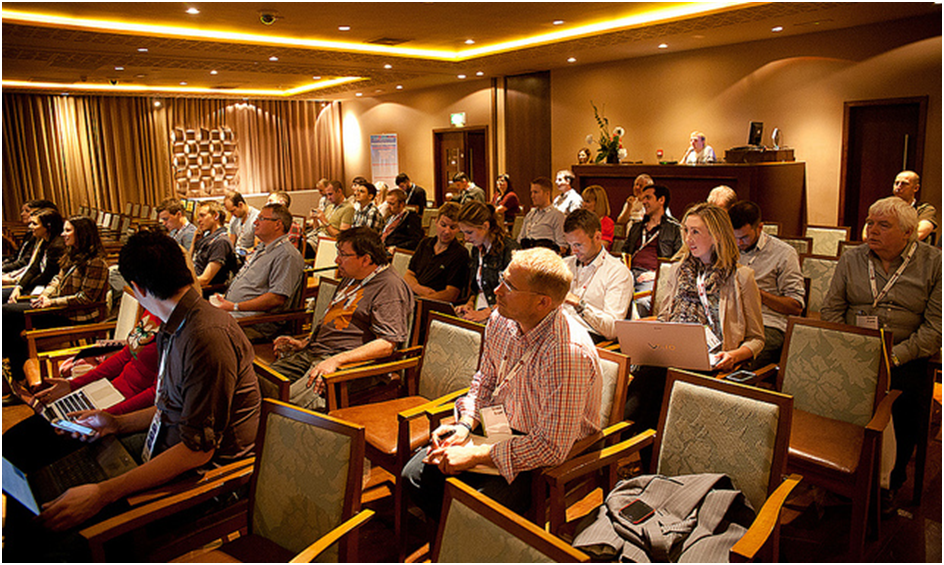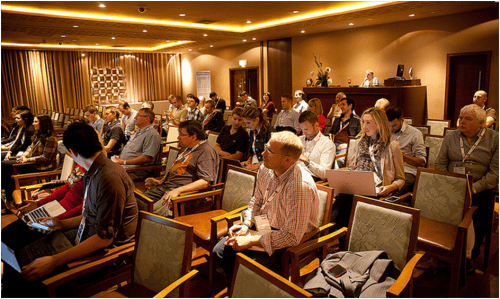Conferences can be pricey and few of them really stand out. Over the years Think Visibility, a twice-yearly SEO conference is one of the few that does, thanks in no small part to its straight talking playful creator. Cat Mansell, Senior SEO Analyst at Leeds agency Epiphany and secret squirrel of produce at Out of Yorkshire lets us peek inside her notebook.
Saturday 1st September was the 8th Think Visibility conference; an online marketing conference covering a variety of topics from technical SEO and affiliate marketing to building an online community and PR.
The day was hosted by Dom Hodgson and included talks by knowledgeable speakers including Hannah Smith from Distilled and Bas van den Beld from State of Search as well as the lunchtime “entertainment” of rankety rank. For those who missed it, here’s my whistle stop tour of talks I saw and tools I learnt on the day.
Subconscious Marketing: What and How
with Bas van den Beld
An enlightening look at how some brands tap into peoples’ sub conscious to persuade us to buy as well as encourage brand loyalty. There were some valuable takeaways from this talk that could be utilised by businesses big and small. This included influencing the people around your target audience; we care what other people think and therefore we base our decisions on other people. Using techniques such as an “other people bought” feature and social buttons such as “like”, tweet or “+1” on your website’s product pages can help increase sales.
Bas started his talk by telling us that only five per cent of the things we think and do are conscious and the other 95 per cent is part of our subconscious. Therefore, we’re more sensitive to brands when we’re not working because we’re more likely to be positive towards brands that we associate with times when we are relaxed and happy.
Creating a Community Using WordPress
with Charlotte Britton
Charlotte has created and runs her own WordPress site, www.onlandscape.co.uk; a community for landscape photographers. Her first-hand experience meant she was able to provide some constructive insights for anyone looking to set up their own online community. She began by explaining the importance of working with people with similar goals and interests and choosing a specific niche for your online community that you can be knowledgeable and passionate about.
The talk covered paid versus free content for your online community. It’s important to have a certain amount of good quality and regularly updated content for your SEO efforts but Charlotte has found that a paid model where extra content is available through subscription works well. However, she recommended considering what your audience would accept and whether they would prefer to pay for access e.g. monthly, quarterly, six monthly or annually.
She went on to discuss the type of content you are producing for your audience i.e. try and find a balance between video, podcast and written content. Using techniques such as guest authors, discussing hot topics and monthly features can help to increase your readership. Charlotte suggested starting with just blog posts with comments enabled initially before jumping into building a forum – waiting until you have a decent readership and user engagement will create a better impression.
Lastly, when you’re choosing what plugins to use look for good reviews and plugins that have been locally developed as you’re likely to get a more timely response to any issues. Plugins Charlotte recommended for membership were:
- Your members
- S2 members
- Buddypress
Content Marketing – Beyond the Bullshit
with Hannah Smith
Hannah, an SEO consultant for search agency ‘Distilled’, discussed a problem many online marketing and search agencies can face when creating content for a brand’s website i.e. creating content that will gain good quality and authoritative links but is also on-brand.
Creative content that is designed to purely gain links can often be off-brand, Hannah referred to the “Linkerati” traditionally linking to, “zombies, bacon, cats, conspiracy theories, controversy and drama”. It’s not that surprising then that many brands do not want to be associated with this kind of content.
There has to be a compromise; content needs to support brand positioning, not just act as link bait. It also needs to be truly impressive content. Hannah used the example of salon.com to illustrate this point that quality is more important than quantity. Salon.com posted 33% fewer articles over the course of a year but generated 40% more traffic because they took more time over what they want to talk about and how they wanted to present it.
Hannah discussed different examples of creating content that supported brand positioning. For example, simplybusiness.com, an insurance company that wanted to become an authority for small businesses, created resources on different topics such as using social media, improving productivity and setting up an Adwords campaign. This content generated good quality and relevant links as well as being useful to the company’s customers. Although this kind of content isn’t going to create as many links as content about, “zombies, bacon, cats, conspiracy theories, controversy and drama” it is valuable to the company’s customers, on-brand and in line with the business objectives which is just as important.
An SEO’s Guide to Magento Commerce
with Paul Rogers
Paul Rogers, head of digital marketing as GPMD, discussed the e-Commerce platform ‘Magento’ and how to make it SEO-friendly. This was quite a technical talk that covered the main points to consider when setting up a website using Magento. I felt much of this would be useful advice for ensuring your website was SEO-friendly for anyone who was relatively new to SEO, even if you choose a different e-Commerce platform to Magento.
Paul explained how there were a couple of things set by default by Magento ‘out-of-the-box’ that should be updated for SEO. The first of these were redirects which are 302 redirects by default, this means that the full value of links pointing to a page that has been redirected won’t be passed back into the domain. This can be change to 301 redirects in Magento’s admin panel.
Secondly, the <h1> is the logo by default, this can also be updated so that the page headline utilises the <h1> tag instead. A bug with Magento is that it creates duplicate URLs; creating the same URL with and without a trailing slash. Unfortunately the platform does not allow you to simply create a rule to 301 redirect one URL to the other. To get around this problem you will need to set up manual redirects or implement the canonical tag across the site pages (although this is not ideal).
Another good piece of advice for anyone using Magento or thinking about using this platform to set up their next website is to disallow the /catalogsearch/ directory in robots.txt and additionally request it is removed via Google Webmaster Tools. This directory is created by the internal search function and so can create a potentially large duplicate content issue if not removed from Google’s index.
So there you have it. A run down of top tips from some of the leading digital experts that could have cost you a pretty penny or two, all for nowt. You’re welcome.


The moment you purchase (and in some instances, just visit) – the owners at GotApex.com receive a reward.
You may not access the .uk WHOIS or use any data from it except as permitted
by the terms of use available in full at